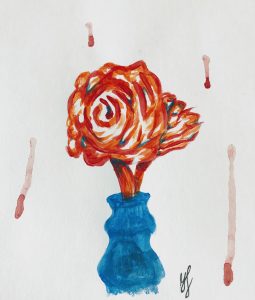
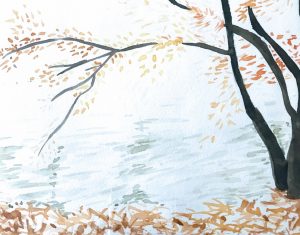
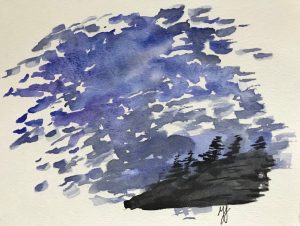
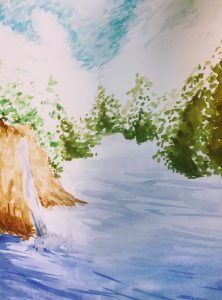
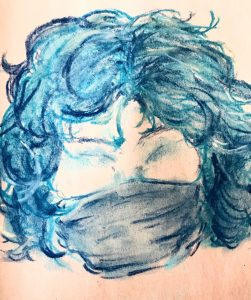
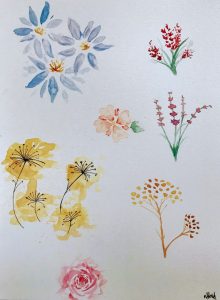
Archives
Artwork by Riley Dinerman
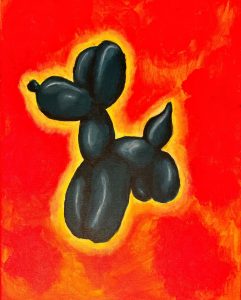

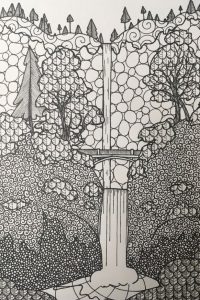
An Ode to My Journal
Characters turn into words,
Turn into lines, turn into stanzas.
Letters hum in a phenomenal symphony
Orchestrated by a composer of much experience.
The beauty of it cannot be described or obtained,
Only viewed.
Creativity flows through my veins
Like blood as I attract
Pen to paper, a relationship unmatched by others.
As i scribe your presence, you start to fade from my memories,
Now only commemorated on a thin, vulnerable sheet.
With your appeal, you draw me in
and allow me to express my perspective whether I choose to or not.
You’re the catalyst of my reflections,
The canvas for my masterpiece.
The home for my thoughts.
The mirror to my reality.
You highlight growth
That simply would’ve been overlooked
By my blind, ignorant, human eyes.
You never judge or criticize me and my abilities,
Only act as a support system.
You make me proud of my accomplishments.
You make me proud of my writing.
You make me proud of me.
You make me “Me”.
You are me.
LoRon Pearson, age 16
Home is Me
Whether it’s the November chill clutching onto my cheeks, clawing its way down to my thighs as I hear the salty waves crash onto shore – or it’s the warmth of my bedroom, rain pattering on my windows, music transporting me to another world… Home is where I feel safe, where I can be who I am and not feel judged or afraid. Home is wherever I decide it to be, and that’s better than any house, any skeleton of a building that I merely occupy. Home is wherever I am, wherever I blossom, wherever I grow, wherever I learn.
Home is me. I am my home.
Maxwell is a 7th grader in West Philadelphia. In his spare time, he likes to write, make music, and draw. His biggest inspiration when making all kinds of art is what he sees around him and events going on in the world.
Three Stages of Lifetimes
The red brick row home
Here the sun shines through the broken glass windows
The silent cries of the rising yellow crescent sunsets
The sounds still foreign to me
Here is the row home
Rebuilt
Reborn
Three stages of lifetimes
Three roads watching Dorthy walk by without her ruby slippers
Is there a place like home?
Blood of open wounds traveling down the wooden staircase
There’s no place like home
Flying monkeys eating through the gas stove
Gasoline smells throughout the house
Bottles throughout the rooms
The tinman may need a body
Gasoline cans won’t hold him much longer
Living room bare
The shine of the silver moon
Brings spirits dancing around
Like a ballroom
The creaking of the floors has lost its fight
This old row home won the game
The girl with the gapped tooth smiles
Waiting on the porch clicking her ruby slippers
Three times
Humming…
There’s no place like Philly home
There’s no place like Philly home
There’s no place like Philly home…
Laniyah Emile attends Franklin Learning Center High School in Philadelphia, PA. She started writing poetry during the pandemic while the world was silent. She wrote loud and passionate words in her notebook during her free time, and those lovely moments paid off.
The Place To Be
Home. The feeling of home, the smell of home is wonderful. You smell your mom making homemade food. You feel the soft blanket on you while watching a movie. You smell the fresh air through your window and feel the cold air on your face. It smells like the park you played in with your friend or the feeling of playing in the snow. But even though you have fun being outside, you still remember home.
There are a lot of different things that families do at home. Some like to spend time with each other while others go on their own paths. Some like to clean their home every day while some clean whenever people come over. Some decorate their home every holiday while others don’t. It doesn’t matter, it’s still home.
Many memories are made at home like welcoming home a new family member, having parties with friends and family and playing games and watching movies with your family and friends. No matter where you go you bring these memories with you. You may get homesick and when you do, you can go home.
Home. It’s a shelter. It’s family. It’s a memory. It’s love. It’s the place to be.
My name is Tobi Gonzalez. I’m 9 years old. I’m currently in 4th grade at George W. Nebinger Elementary School. I live with my dad, mom and toddler brother in South Philly. My favorite subject at school is math. I also love to do art and to write. I mostly make abstract drawings and paintings and write realistic fiction stories. I’m a person that likes to make others laugh and be happy. I draw pictures and text inspiring quotes to my friends and to my family to make them smile.
The Tale of the Two Lovers
She deserved the world. She deserved me, he told himself. His love for the girl was beyond the heavens and earth, the stars in the galaxy – infinite. He craved her, she was everything he wanted and more; her smile was soothing like the ripples of the ocean, and her eyes resembled sweet honey nectar. They lived In the woods, in peace, the voices of the birds heard as they soared through the sky.
They were alone, with not a single being to be witnessed. The naked trees that guarded the woods could be seen through the dark hole of the window as the gaps of moon light peered in. “I love her, she needs me, and what I did was good for her. She’s happy now, peaceful,¨ thought the boy. He knew that the girl lived an unfortunate life. Everyone would say how good she was, how beautiful she looked, how funny she could be, and yet they´d hurt her and led her astray. He wanted to be the one to love her and put her out of her misery.
He held her hand, his was endowed with warmth while hers was cold as ice, ¨I want to take you somewhere special,“ he whispered to the girl. She was silent and he took that as a yes. As he entered the woods, the night air carried something vile. He carried the silent being he loved most in the world as the cricket’s melody filled the air. Trees greeted them while the stars lit the two love birds through the darkened woods. The boy, madly in love, allowed his lungs to be filled with the moist, crisp air. He took the girl to the river near the stranded walnut wooden cabin. He always wanted to take her there. It was beautiful, bewitching,and angelic just like her. He viewed her striking features once again. He listened as the river crashed against the rocks.
He held the girl close to him and gave her a kiss on her cheek. The moon hovered over the two and watched above as they held hands once again, his were warm while hers was cold. He simply couldn’t let go yet he knew it was for the best, ¨At last you shall be free,¨ he said to the girl as her hushed rotten corpse sank along the river stream. She was truly free….
Nahla Colon is an inspiring writer and poet who wishes to grant her eternal passion of literature with others. She developed her love for writing from a young age by her fondness of reading and using her imagination to escape to a world of her own. She involves herself in hobbies such as traveling, writing, reading, and simply adores Mother Nature and all of her hidden beauty. Nahla, when she’s older, longs to live in a field of flowers with the one she loves most and write away her feelings as the sun kisses her skin and the earth neighbors her.
Titleless Suspense
As I crept in the night,
I heard a creature tiptoeing up the steps.
I heard its heart beating, oblivious and unsuspecting.
Tha-Thump-Tha-Thump…
Ignorant to the dangers that lurk in the dark.
In particular,
ME.
Sixteen stairs for them to climb,
And one by one they go.
So amusingly incognizant.
Tha-Thump-Tha-Thump…
And as they get closer to the top,
They just don’t know
It’s About To Go Down…
BOO!!!!
Its heart races at the speed of light.
Terror engulfs its face.
It cries and screams in terror,
And then I turn on the lights…
“What’s up, sis?”
Anthony Wallace is 14 years old with a wide variety of interests. Along with writing, his interests include reading, aerospace engineering, playing basketball (and burying his opponents 100 feet under), cooking, and “being the best me that I can be.”
Just a Small Town
The dark clouds boomed loudly, making a thump. I ran quickly into the gas station, splashing water into my shoes. The bell rang as I walked into the candy-filled store. Finally, a familiar face! “Uh- Aira! Didn’t know I’d see you..”, she looks down at the register. Blue shuffled awkwardly, putting her hands behind her back. I looked down, grabbing a white chocolate Hershey’s bar. I didn’t want her to feel awkward. I pull out my small pocket book, meticulously counting every coin. I’ll have to have ramen again tonight. Blue comes back from behind the counter. “Is that all?”, she asks, “Sure.”
I walk back outside into the rain, my apartment is just across the street. I run across, looking quickly for any cars. I glance behind me and see a shadow slipping into the darkness. The Ring doorbell,bright blue light, makes me remember I forgot my keys. Oops. Buzz. “Who is it?” I hear in a monotone voice.
“Ma- Aira. I forgot my keys.” I can never remember the new name. “Hey, uh, Mr.Webber it’s me.” I make an awkward laugh. “Could you use the spare I made for you?”
I can hear his uneven breathing louder than a choir. He’s old. “Okay,”. I hear the click of the door. I pat off my shiny shoes. The mess of bright orange hair, Toney, the elevator guy, greets me. “Rainy day innit?” he says in a thick Irish accent. “Yeah.” I avoid contact with him, maybe out of habit, or disrespect. The ride is quick, an awkward smile is shared between us. “Bye”, I say, I wave. I hear him say “exiting ele-” and then this weird static when I leave. He’s probably just confirming I got off.
My hand gets wet when I reach my hand back into my pocket to grab my Hershey bar. I rip it open, smelling the condensed milk. I take a bite, and it melts in my mouth. My eyes shut with satisfaction as memories rush back to me. I remember getting my first car with a basket of hershey bars. My inner peace is satisfied. After the 3 months I’ve had, I deserve it. I see the lump on the rug, and yell “Thanks Mr. Webber!” to the room next door. The door makes a satisfying click when it unlocks, I swing open the creaky door. I switch the light on, revealing my apartment. I’m annoyed at the boxes in the corner, I should’ve unpacked them at the beginning of my move. I’ll just do it right now.
The pictures in the box brought back memories of everything: pictures of me and my dad, others of me in the pool, in my humongous room, and in the car. God, I miss that room. It wasn’t that long ago before everything changed. I still remember the smell of dollar bills, it was nothing compared to what I have now. My trashy apartment reminds me of the palace I had before. I remember scrubbing the blood stains out of the carpet, the musty smell of the old dish soap, and the bright alarming police tape. I should focus on the good memories. I remembered getting a new Louis bag, marveling over the shiny gold on the luxurious handbag. I should’ve had that, and more. If it weren’t for him… but now all the pictures with my family are worthless, I’ve moved on. I grab a black trash bag and throw them out hastily, as to not bear another surge of jealousy for what I could have still had.
I have to clean all of this, it’s a mess. I’ve been out for most of the day. I turn on the radio, it plays “Firework” by Katy Perry. I dance around with my eyes closed, feeling the beat. A moment of freeness and passion always comes in this song, between jumps during the chorus.The music lasts for a few seconds. “Ads… shoot”, I mumble under my breath. Could this day get any worse? I scroll on the radio, finding nothing on the FM channel. “AM it is”. Static. When I was just about to turn it off, I heard a voice. At first it was just static, going in and out. “In- the- apart- 306”. That’s my room number. I listen, furrowing my eyebrows. “Sir? When are we going to take her?”. I turn up the volume. “We’ll decide later. How much will we get, Blue?”. Blue? Blue, that’s my only friend! The only person who had been nice to me. The only one. “4 million, Sir, from dad’s-”, it cuts off. I click the button to turn the radio off, with tears in my eyes. I would never think anyone would betray me like this. Oh God, what do I do? I fall to the floor, bending against the wall. My arms curl towards my head while I sob internally. I can’t breathe!
I need to call someone, my old best friend. She wouldn’t betray me would she?
I pick up the phone slowly, dialing her number. My eyes gloss over with tears. “Ellawyn?” I ask, my voice cracking. “Oh my god, M, are you okay? I haven’t seen you in so long, where are you?”, Ellawyn was always worrying about me.
I cut her off. “They’re following me, I can’t- I just don’t know what to do.”, she seems confused. “Who’s following you? Are you okay? I know all the things with your dad, you know the court and the will. It was supposed to have you in it, but you’re doing ok…. Right?”. I dodge her questions once more. “I know, that’s why they’re following me.”
“Who?”
“Look, I don’t know, okay?”. My head is racing, moving faster than a race car. “My dad’s debt, he had all the taxes, right? They must be here for that, he didn’t pay them.” I sob, trying to pull myself together. My head is hot, I just need to get it all out.
“I know the money was a huge let-down for you, you wanted to go to Yale or whatever. Why are they following you? It’s not your fault, you didn’t make the debt. It went to you when he…you know. But I thought…. Why are they following you? You haven’t done anything!”
“Because I killed him, Ell.”
She goes silent.
Adaline Sand is a 12 year old from West Philadelphia. She goes to SLA@Beeber middle school as a 7th grader while enjoying her time at Mighty Writers every week. Adaline has been going to MW since September of 2021.
A Fox, Snow Leopard, and iPhone 13
A snow leopard, named Snowy, lived in the Himalayan mountains while a fox lived deep down in the grasslands. The fox, named Nick, traveled up to the mountains. Once at the top of the mountain he saw the snow leopard. The fox at first was surprised and nervous but after Snowy smiled and growled at Nick, they both burst out in a huge laugh. They quickly became friends and decided to travel to New York. They started their journey by packing huge nutritious lunches.
Snowy said good-bye to his family and Nick wrote his family a good-bye letter. They were almost to New York when in Pennsylvania, an angry mob of Earth ponies ambushed them. The ponies appeared extremely angry and Nick and Snowy had no idea why. A pony named Hitch chased them to New York.
In New York they arrived in Madison Square Garden and saw an ad about the brand new iPhone 13! They turned to each other and said, “What is that? We have to have it!” Right after saying that, a person walking by dropped their brand new iPhone 13, and Nick swiftly picked it up! Snowy and Nick ran so fast but did not know where to go.
After running for what felt like forever (though it was really only 10 minutes), the phone began buzzing, and before they knew what was happening they were surrounded by the person who dropped the phone and zookeepers! Nick and Snowy were sent to the Philadelphia Zoo because they got caught with the item when the owner tracked their phone. What a costly and sad lesson Nick and Snowy learned and they never hoped to see an iPhone again!
Nusayb McCain, age 8